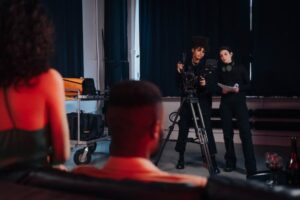Real-time 3D is a revolutionary technology we might be most familiar with from the videogame industry, which has been employed for many years. Real-time 3D creates animations and images for the human eye to perceive them as real. Today, technology is altering entire sectors and finding new applications outside gaming. For instance, businesses that use the technology can provide clients with a preview of their prospective homes before construction has even begun. This is a significant marketing advantage for those businesses.

What is real-time 3D?
Using software that produces 2D graphics based on three-dimensional scenes, graphic information is developed in a multi-step process known as 3D. Real-time 3D entails creating a model digitally that can be turned and rotated. Therefore, it’s not only an issue of showing static 3D photos; the model can be rotated to be seen from all sides. In contrast to still picture rendering, real-time rendering enables model modifications with instantaneous visual feedback.
The Real-time 3D solution is a graphics system that analyzes, optimizes, and generates 3D images in real-time. With the right software, companies and developers can digitally create models, environments, and fully interactive worlds in nanoseconds. In 3D concept, a computer system transforms a 3D wireframe model into a 2D image of him enhanced with his photorealistic three-dimensional effects.
Over the years, innovators have developed two forms of 3D rendering: pre-rendering and real-time rendering. Pre-rendering creates 3D images of him and displays them statically in the environment, thus eliminating real-time interaction and customization options. Real-time 3D rendering creates images and assets instantly and at high speed. This means companies like video game developers can create giant virtual environments that users can navigate. The software uses concepts such as light and depth to enhance the experience and provide the highest possible level of photorealism. Images are typically generated with a minimum rendering speed of 24 frames per second. This is the minimum speed required for the human eye to perceive rapid motion.
How does it work?
The triangles make up the product’s 3D picture to provide a more technical explanation. A triangular model is built by building each triangle one at a time and positioning each one in a particular location (width, depth, and height). Other shortcuts allow the creation of numerous polygons rather than arranging them one at a time. Finally, a model consists of hundreds or hundreds of thousands of triangles.
When a moving box is closed, for instance, it is a straightforward model with only six sides. You next employ twelve triangles. Suppose you want to design a sofa with lots of curves. Also, there are a variety of lighting techniques that you may use to design a chic and lifelike replica of the sofa. As technology develops, it becomes easier to compare 3D lighting to how light and illumination function in the real world.
Working with reflections by changing light and shade is crucial to creating realistic visuals. Shadows form in areas where the light cannot penetrate. The outcome depends in part on how an object is lit. Depending on how the light hits the object, reflections are produced. A significant factor is the light’s brightness and the object’s surface.

What are the benefits?
If you have a model automobile, you can play around with the appearance by altering the rim color or the paint. As every change is shown in real-time, it is possible to observe how various designs seem while the change is being done. Real-time 3D thus opens up brand-new possibilities for businesses and their clients. With technology, for instance, architects and designers can test their concepts to see how they might seem in practice. Also, this has lots of advantages for marketing. Customers can tour their future homes even before the building begins. Buyers can also play with interior design elements, trying various combinations of wall color, wallpaper, flooring, and other elements.

Which industries use Real-time 3D?
The video gaming industry is best known for its widespread use of 3D technology. Also, 3D rendering is used by architects, product designers, and the film and advertising industries. Almost all sectors can benefit from Real-time 3D rendering if the actual goods are offered as commodities.
E-Commerce
A substantial boost to e-commerce comes from 3D rendering. Businesses now have the chance to present their items to clients brand-newly, simulating an in-person shopping experience. Customers may engage with a product and view it from all possible perspectives thanks to 3D rendering. Because of 3D rendering, you, as a customer, experience a bag entirely differently than you would if you had only viewed images of it before making a purchase. The degree of the customer experience increases when clients can customize the product independently.
Manufacturing
It is feasible to construct a real-time 3D model of a product in a digital form and verify that all components function as they should before the product is created; manufacturers can tremendously benefit from 3D rendering. Another option is to plan a whole lab by making various 3D models. Because they may be set up in the space, you can ensure that all components function together. Using AR and VR, you can install a product into an existing lab and see if it fits, unlike a 2D sketch. For instance, verifying that the product isn’t taller than the ceiling height is feasible, which can be challenging to see on a 2D sketch viewed from above.
Media and Entertainment
Marketing benefits greatly from demonstrating a product to a buyer and closing a sale before the product is available. The media and entertainment sector can employ 3D rendering to produce animations and sequences that tell a story.
Gaming
One of the most cited use cases for real-time 3D is gaming environments. Video games have used 3D graphics for years, but Real-time 3D makes developing these images more accessible, faster, and cheaper. Real-time 3D reduces load times for virtual assets and paves the way for XR gaming.
Training
Trainees can interact with high-resolution renderings of the equipment and materials they work with in real time, providing greater immersion. In addition, real-time 3D solutions can be used in training environments to help users practice different skills in a realistic space. For example, a surgeon can practice specific techniques with her 3D body reacting to her actions.
What is the software in Real-time 3D rendering?
You can use different 3D engines depending on what you want to achieve. One of the most famous is the Unreal Engine. Unreal Engine is a leading 3D engine that delivers incredible photorealistic experiences. Unreal Engine was developed by Epic Games, which is also responsible for developing several popular video games such as Fortnite.
Unreal Engine is a very popular game engine that can be used to display products such as cars and other automobiles in very high photorealistic quality. The more detail you can see how your car’s paint shines and the different materials inside your car look, the more you can visualize your car in such high quality. Animech works well with Unreal Engine but also supports 3D visualization on the web, so you should use a web-friendly 3D engine.
Play Canvas uses OpenGL and is the same game engine as Unreal Engine, except that it is suitable for mobile applications such as web browsers and mobile phones. Because of this, everything can be rendered through the web browser, so the graphics quality is a bit lower, but on the other hand, the 3D Engine of this type is more “public” and has the opportunity to be accessed by the world. With the help of Play Canvas, you can create applications that work not only on mobile phones but also on tablets and laptops. So, which 3D Engine you choose depends on your project goals and what you want to achieve.
What is Real-time 3D content?
Real-time 3D (RT3D) is a graphics technology that generates content faster than human perception. In simpler words, unlike cinema, which creates motion but provides the audience with the same passive experience. Real-time 3D is a digital reality that feels real while controlling your experience, much like a video game. The primary use for real-time 3D in companies is to create and deliver digital representations of buildings or objects that combine information from data sources such as metadata and sensors. Also known as digital twins, these representations look and behave like physical products and can be experienced on mobile devices, computers, augmented reality (AR), virtual reality (VR) headsets, and other platforms.
How are Real time 3D created?
A typical real-time 3D AEC workflow starts with the ingestion of existing content. Imported 3D geometry and metadata can be in many formats, including but not limited to:
- Building information modeling (BIM) data
- Data capture of products and places
- Meshes from 3D modeling and visualization applications
- Computer-aided design (CAD) models
How does Real-time 3D impact business?
McKinsey & Company reports that 20% of construction projects are ahead of schedule, and 80% are over budget. These difficulties deepened in the 2020 pandemic situation. Companies using real-time 3D are well-positioned to meet these challenges. Research has shown that real-time 3D offers the following benefits:
- Saves cost
- Boosting business
- Easy communication
- Faster marketing
Videos
Realtime 3D Video Production is here! (Unreal Engine Tutorial)
How real-time 3D is transforming global industries
Reimagine the automotive lifecycle with real-time 3D | Unity
The power of real-time 3D marketing | Unity










